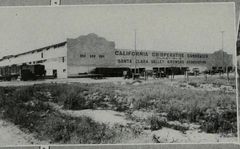Difference between revisions of "California Cooperative Canneries"
| Line 6: | Line 6: | ||
}} | }} | ||
[[File:California-cooperative-canneries_from_pacific_service_magazine_1926.jpg|240px|thumb|right|California Cooperative Canneries, San Jose, 1926.<ref>[https://archive.org/stream/pacificservicema1627paci/pacificservicema1627paci#page/n348/mode/1up Pacific Service Magazine, October 1926].</ref>]] | [[File:California-cooperative-canneries_from_pacific_service_magazine_1926.jpg|240px|thumb|right|California Cooperative Canneries, San Jose, 1926.<ref>[https://archive.org/stream/pacificservicema1627paci/pacificservicema1627paci#page/n348/mode/1up Pacific Service Magazine, October 1926].</ref>]] | ||
| − | '''California Cooperative Canneries''' was an Armour-affiliated cannery, founded in 1919 as part of the meat packing company's attempt to expand once again into fruits and vegetables. Although nominally independent, California Cooperative Canneries had a ten year contract to sell its full production to Armour. Armour argued that the setup would give farmers more flexibility and profits, but others saw it as an attempt by the meat-packers to dominate another area of food production. | + | '''California Cooperative Canneries''' was an Armour-affiliated cannery, founded in 1919 as part of the meat packing company's attempt to expand once again into fruits and vegetables. Although nominally independent, California Cooperative Canneries had a ten year contract to sell its full production to Armour. Armour argued that the setup would give farmers more flexibility and profits, but others saw it as an attempt by the meat-packers to dominate another area of food production. |
| + | |||
| + | The movement sparked an epic anti-trust battle between the US Government and Armour and Swift, leading to a consent decree against the meat-packers; Armour relinquished the company soon after. There are signs that the canneries were to be sold to [[Bisceglia Brothers]], with the new company continuing to sell to Armour<ref>[http://news.google.com/newspapers?id=cB8yAAAAIBAJ&sjid=MeQFAAAAIBAJ&pg=1296%2C265046 January 7, 1920 Evening News]</ref> [[Bisceglia Brothers]] will continue contracts with Armour. By 1924, the "independent" canneries were | ||
[http://www.archive.org/stream/investigationofc16unit/investigationofc16unit_djvu.txt deeply in debt] to packers. The consent decree was suspended from 1925 to 1929; the Supreme Court ruled anti-trust action was appropriate<ref>Thomas C. Blaisdell, [http://books.google.com/books?id=N8dZkGO6i-AC&pg=PA202&lpg=PA202&dq=%22California+Cooperative+Canneries%22+armour&source=bl&ots=9qAOHPid3v&sig=yJYT4K27iWHa-rnYpP0BwtudQPM&hl=en&sa=X&ei=72BcT9eLK-isiQLS_JTYDA&ved=0CEcQ6AEwBg#v=onepage&q=%22California%20Cooperative%20Canneries%22%20armour&f=false An Experiment in the Control of Business]. 2008, Lawbook Exchange Ltd. p. 202. Originally published by Columbia University Press in 1932.</ref>. Eventually, they were allowed to keep the business<ref>[http://newspaperarchive.com/bakersfield-californian/1929-05-20/page-2 May 20, 1929 Bakersfield Californian].</ref>. Even then, the canneries only survived a few more years, being sold to [[Tri-Valley Growers | Tri-Valley Packing]] in 1932. | [http://www.archive.org/stream/investigationofc16unit/investigationofc16unit_djvu.txt deeply in debt] to packers. The consent decree was suspended from 1925 to 1929; the Supreme Court ruled anti-trust action was appropriate<ref>Thomas C. Blaisdell, [http://books.google.com/books?id=N8dZkGO6i-AC&pg=PA202&lpg=PA202&dq=%22California+Cooperative+Canneries%22+armour&source=bl&ots=9qAOHPid3v&sig=yJYT4K27iWHa-rnYpP0BwtudQPM&hl=en&sa=X&ei=72BcT9eLK-isiQLS_JTYDA&ved=0CEcQ6AEwBg#v=onepage&q=%22California%20Cooperative%20Canneries%22%20armour&f=false An Experiment in the Control of Business]. 2008, Lawbook Exchange Ltd. p. 202. Originally published by Columbia University Press in 1932.</ref>. Eventually, they were allowed to keep the business<ref>[http://newspaperarchive.com/bakersfield-californian/1929-05-20/page-2 May 20, 1929 Bakersfield Californian].</ref>. Even then, the canneries only survived a few more years, being sold to [[Tri-Valley Growers | Tri-Valley Packing]] in 1932. | ||
Revision as of 03:14, 16 January 2015
| Business |
Cannery |
|---|---|
| Brands |
X Ray, Suncarest, Dew Taste, Calamade, Cock o' the Walk. |
| Aliases |
Santa Clara Valley Growers Association |
| Successors |
Tri-Valley Packing |

California Cooperative Canneries was an Armour-affiliated cannery, founded in 1919 as part of the meat packing company's attempt to expand once again into fruits and vegetables. Although nominally independent, California Cooperative Canneries had a ten year contract to sell its full production to Armour. Armour argued that the setup would give farmers more flexibility and profits, but others saw it as an attempt by the meat-packers to dominate another area of food production.
The movement sparked an epic anti-trust battle between the US Government and Armour and Swift, leading to a consent decree against the meat-packers; Armour relinquished the company soon after. There are signs that the canneries were to be sold to Bisceglia Brothers, with the new company continuing to sell to Armour[2] Bisceglia Brothers will continue contracts with Armour. By 1924, the "independent" canneries were deeply in debt to packers. The consent decree was suspended from 1925 to 1929; the Supreme Court ruled anti-trust action was appropriate[3]. Eventually, they were allowed to keep the business[4]. Even then, the canneries only survived a few more years, being sold to Tri-Valley Packing in 1932.
In 1920, the president was S. E. Johnson, with Albert Jaentze as secretary[5]. The company's manager was Vernon Campbell in 1921; he shows up in many press quotes during the early founding of the company. Floyd Bohnett, an enthusiastic member in 1922[6], also appeared in the press.
A 1922 Canners Directory shows sites in San Jose and Modesto, with offices in Cunard Building in San Francisco[7]. San Jose's plant was one of the biggest canneries in the county in 1922; a 1922 history noted "There are forty canning factories in the county. One of these, the Co-operative plant, is the largest in the world. In 1921 it absorbed 30,000 tons of fruit and employed nearly 1,000 people. In the busy season of that year the combined county payroll reached over two million dollars."
Locations
| Location | Years | Address | Details |
|---|---|---|---|
| Hemet | North Harvard Ave., north of Devonshire[8]. | Buildings apparently still exist. | |
| Modesto | 1922 | ||
| San Francisco | 1922 | Cunard Building | |
| San Jose | 1920, 1922 | Tenth and Taylor | |
| Tulare | 1920 | ||
| Visalia | 1920 |
References
- ↑ Pacific Service Magazine, October 1926.
- ↑ January 7, 1920 Evening News
- ↑ Thomas C. Blaisdell, An Experiment in the Control of Business. 2008, Lawbook Exchange Ltd. p. 202. Originally published by Columbia University Press in 1932.
- ↑ May 20, 1929 Bakersfield Californian.
- ↑ California Co-Operative Canneries: California Food Products directory. 1920, A. Marks, San Francisco.
- ↑ Floyd Bohnett biography.
- ↑ 1922 Cannery's Directory
- ↑ Packing Houses of Southern California.